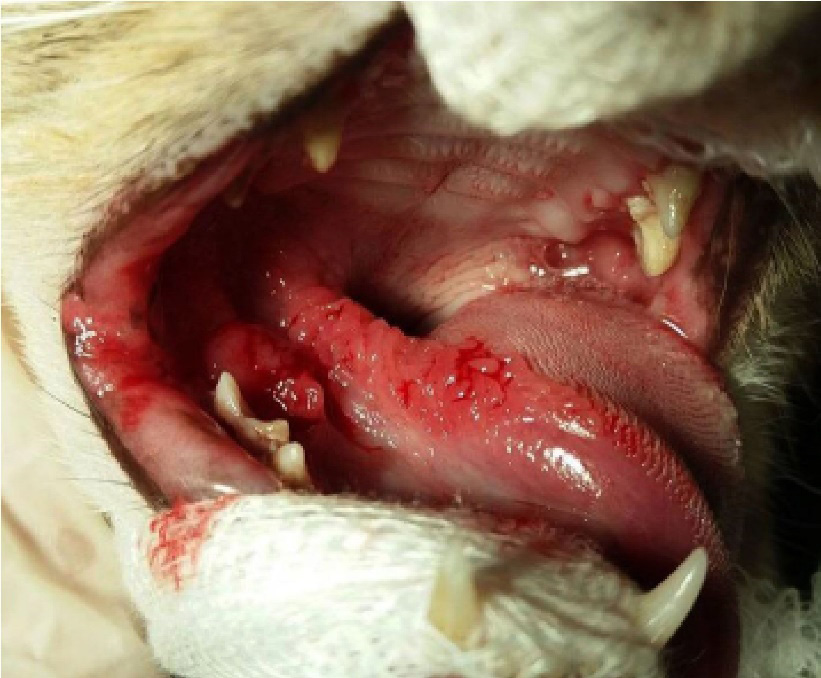Triple Viral Infections in The Same Cats: Feline Coronavirus, Feline Parvovirus, Feline Foamy Virus
Infección viral triple en el mismo gato: Feline Coronavirus, Feline Parvovirus, Feline Foamy Virus

Show authors biography
Objective. Several studies from different countries have been performed about the viral diseases of domestic cats, and detailed information has been provided on their transmission, prevalence/incidence, virulence, origins/molecular characteristics and pathogenesis so far. Multiple- or co-infections in domestic and wild cats have been described by many papers. However, viral co-infections have been reported on a limited basis. In this study, three domestic clinically diseased cats have been found to be positive with feline coronavirus (FCoV), feline parvovirus (FPV) and feline foamy virus (FFoV). We aimed to examine triple viral infections circumstances in Turkish cats. Material and method. Ascites and blood samples were collected from diseased cats. Different polymerase chain reaction protocols for each virus were performed. After PCRs, all products were run in agarose gel and visualized under a blue-light transilluminator. Results. We found FCoV, FPV and FFoV as triple infection in three cats. Conclusions. We think that the results indicating the presence of multiple infections will ease the work of veterinary clinicians concerning infection treatment options, especially when animals show multiple clinical findings due to co-infections. It should be not forgotten the presence of multi-systemic co-infections in early routine laboratory diagnosis.
Article visits 1002 | PDF visits
Downloads
- Muz D, Oğuzoğlu TÇ, Timurkan MÖ, Akın H. Characterization of the partial VP2 gene region of canine parvoviruses in domestic cats from Turkey. Virus Genes. 2012; 44(2):301–308. https://doi.org/10.1007/s11262-011-0703-8
- Sellon R, Hartman K. Infectious diseases of the dog and cat. 4th Edition. Section I: Viral, Rickettsial, Chlamydial, and Mycoplasmal Diseases. MO: Elsevier Saunders, 2006.
- Koç BT. Kedilerde görülen Retrovirus Enfeksiyonlarının (FIV, FeLV, FFV) Moleküler Olarak Araştırılması. PhD Thesis. Ankara University, TR; 2018. https://tez.yok.gov.tr/UlusalTezMerkezi/tezSorguSonucYeni.jsp
- Can-Şahna K, Ataseven VS, Pınar D, Oğuzoğlu TÇ. The detection of feline coronaviruses in blood samples from cats by mRNA RT-PCR. J Feline Med Surg. 2007; 9(5):369–372. https://doi.org/10.1016/j.jfms.2007.03.002
- Buonavoglia C, Martella V, Pratelli A, Tempesta M, Cavalli A, Buonavoglia D, et al. Evidence for evolution of canine parvovirus type 2 in Italy. J Gen Virol. 2001; 82:3021–3025. https://doi.org/10.1099/0022-1317-82-12-3021
- Simons FA, Vennema H, Rofina JE, Pol JM, Horzinek MC, Rottier PJ, et al. A mRNA PCR for the diagnosis of feline infectious peritonitis. J Virol Methods. 2005; 124(1-2):111–116. https://doi.org/10.1016/j.jviromet.2004.11.012
- Winkler IG, Flügel RM, Löchelt M, Flower RLP. Detection and Molecular Characterisation of Feline Foamy Virus Serotypes in Naturally Infected Cats. Virology. 1998; 247(2):144–151. https://doi.org/10.1006/viro.1998.9232
- Roca AL, Pecon-Slattery J, O’Brien SJ. Genomically Intact Endogenous Feline Leukemia Viruses of Recent Origin. J Virol. 2004; 78(8):4370–4375. https://doi.org/10.1128/JVI.78.8.4370-4375.2004
- Endo Y, Cho KW, Nishigaki K, Momoi Y, Nishimura Y, Mizuno T, et al. Molecular characteristics of malignant lymphomas in cats naturally infected with feline immunodeficiency virus. Vet Immunol Immunopathol. 1997; 57(3-4):153–167. https://doi.org/10.1016/S0165-2427(97)00004-4
- Battilani M, Balboni A, Giunti M, Prosperi S. Co-infection with feline and canine parvovirus in a cat. Vet Ital. 2013; 49:127–129. https://www.izs.it/vet_italiana/2013/49_1/127.pdf
- Frost P, Williams CA. Feline Dental Disease. Vet Clin North Am Small Anim Pract. 1986; 16 (5):851-873. https://doi.org/10.1016/s0195-5616(86)50305-3
- Southerden P. Review of feline oral disease: 1. Periodontitis and chronic gingivostomatitis. In Pract. 2010; 32(1):2–7. https://doi.org/10.1136/inp.b5501
- Rolim VM, Pavarini SP, Campos FS, Pignone V, Faraco C, de Souza Muccillo M, et al. Clinical, pathological, immunohistochemical and molecular characterization of feline chronic gingivostomatitis. J Feline Med Surg. 2017; 19(4):403–409. https://doi.org/10.1177/1098612X16628578
- Sabshin SJ, Levy JK, Tupler T, Tucker SJ, Greiner EC, Leutenegger CM. Enteropathogens identified in cats entering a Florida animal shelter with normal feces or diarrhea. J Am Vet Med Assoc. 2012; 241(3):331–337. https://doi.org/10.2460/javma.241.3.331
- Tenorio AP, Franti CE, Madewell BR, Pedersen NC. Chronic oral infections of cats and their relationship to persistent oral carriage of feline calici-, immunodeficiency, or leukemia viruses. Vet Immunol Immunopathol. 1991; 29(1-2):1–14. https://doi.org/10.1016/0165-2427(91)90048-H























